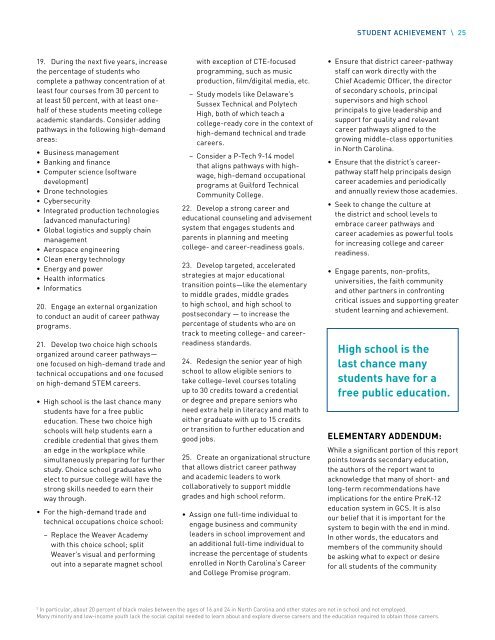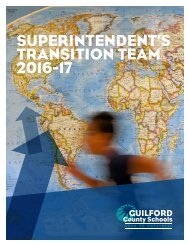Transition Team 2016-17 Final Report
Create successful ePaper yourself
Turn your PDF publications into a flip-book with our unique Google optimized e-Paper software.
STUDENT ACHIEVEMENT \ 25<br />
19. During the next five years, increase<br />
the percentage of students who<br />
complete a pathway concentration of at<br />
least four courses from 30 percent to<br />
at least 50 percent, with at least onehalf<br />
of these students meeting college<br />
academic standards. Consider adding<br />
pathways in the following high-demand<br />
areas:<br />
• Business management<br />
• Banking and finance<br />
• Computer science (software<br />
development)<br />
• Drone technologies<br />
• Cybersecurity<br />
• Integrated production technologies<br />
(advanced manufacturing)<br />
• Global logistics and supply chain<br />
management<br />
• Aerospace engineering<br />
• Clean energy technology<br />
• Energy and power<br />
• Health informatics<br />
• Informatics<br />
20. Engage an external organization<br />
to conduct an audit of career pathway<br />
programs.<br />
21. Develop two choice high schools<br />
organized around career pathways—<br />
one focused on high-demand trade and<br />
technical occupations and one focused<br />
on high-demand STEM careers.<br />
• High school is the last chance many<br />
students have for a free public<br />
education. These two choice high<br />
schools will help students earn a<br />
credible credential that gives them<br />
an edge in the workplace while<br />
simultaneously preparing for further<br />
study. Choice school graduates who<br />
elect to pursue college will have the<br />
strong skills needed to earn their<br />
way through.<br />
• For the high-demand trade and<br />
technical occupations choice school:<br />
−−<br />
Replace the Weaver Academy<br />
with this choice school; split<br />
Weaver’s visual and performing<br />
out into a separate magnet school<br />
with exception of CTE-focused<br />
programming, such as music<br />
production, film/digital media, etc.<br />
−−<br />
Study models like Delaware’s<br />
Sussex Technical and Polytech<br />
High, both of which teach a<br />
college-ready core in the context of<br />
high-demand technical and trade<br />
careers.<br />
−−<br />
Consider a P-Tech 9-14 model<br />
that aligns pathways with highwage,<br />
high-demand occupational<br />
programs at Guilford Technical<br />
Community College.<br />
22. Develop a strong career and<br />
educational counseling and advisement<br />
system that engages students and<br />
parents in planning and meeting<br />
college- and career-readiness goals.<br />
23. Develop targeted, accelerated<br />
strategies at major educational<br />
transition points—like the elementary<br />
to middle grades, middle grades<br />
to high school, and high school to<br />
postsecondary — to increase the<br />
percentage of students who are on<br />
track to meeting college- and careerreadiness<br />
standards.<br />
24. Redesign the senior year of high<br />
school to allow eligible seniors to<br />
take college-level courses totaling<br />
up to 30 credits toward a credential<br />
or degree and prepare seniors who<br />
need extra help in literacy and math to<br />
either graduate with up to 15 credits<br />
or transition to further education and<br />
good jobs.<br />
25. Create an organizational structure<br />
that allows district career pathway<br />
and academic leaders to work<br />
collaboratively to support middle<br />
grades and high school reform.<br />
• Assign one full-time individual to<br />
engage business and community<br />
leaders in school improvement and<br />
an additional full-time individual to<br />
increase the percentage of students<br />
enrolled in North Carolina’s Career<br />
and College Promise program.<br />
• Ensure that district career-pathway<br />
staff can work directly with the<br />
Chief Academic Officer, the director<br />
of secondary schools, principal<br />
supervisors and high school<br />
principals to give leadership and<br />
support for quality and relevant<br />
career pathways aligned to the<br />
growing middle-class opportunities<br />
in North Carolina.<br />
• Ensure that the district’s careerpathway<br />
staff help principals design<br />
career academies and periodically<br />
and annually review those academies.<br />
• Seek to change the culture at<br />
the district and school levels to<br />
embrace career pathways and<br />
career academies as powerful tools<br />
for increasing college and career<br />
readiness.<br />
• Engage parents, non-profits,<br />
universities, the faith community<br />
and other partners in confronting<br />
critical issues and supporting greater<br />
student learning and achievement.<br />
High school is the<br />
last chance many<br />
students have for a<br />
free public education.<br />
ELEMENTARY ADDENDUM:<br />
While a significant portion of this report<br />
points towards secondary education,<br />
the authors of the report want to<br />
acknowledge that many of short- and<br />
long-term recommendations have<br />
implications for the entire PreK-12<br />
education system in GCS. It is also<br />
our belief that it is important for the<br />
system to begin with the end in mind.<br />
In other words, the educators and<br />
members of the community should<br />
be asking what to expect or desire<br />
for all students of the community<br />
3<br />
In particular, about 20 percent of black males between the ages of 16 and 24 in North Carolina and other states are not in school and not employed.<br />
Many minority and low-income youth lack the social capital needed to learn about and explore diverse careers and the education required to obtain those careers.



